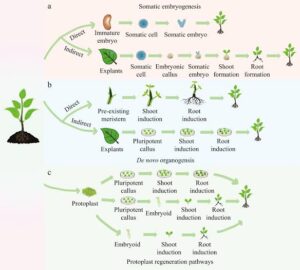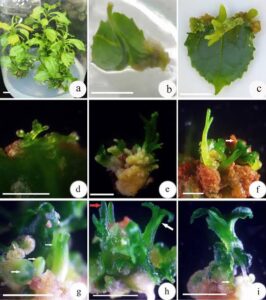Back to: Botany 400 Level
My sharp Afrilearn botanist, how your side dey today? You don ready again, and I dey feel your energy from here! Today we go break down some of the magic tricks scientists dey use inside the lab to turn small plant tissues into complete plants — na the real “science that works.” We go gist about Callus Induction, Organogenesis, and Somatic Embryogenesis. No worry — e go clear like Abakaliki rice water when I finish with you.
Callus induction, organogenesis, and somatic embryogenesis
Have you ever cut a leaf from a plant and seen something begin to grow from the wound after some days? Imagine turning that little wound site into a whole new plant — root, stem, leaf, everything — inside lab conditions. That’s what we dey talk today. With just a small piece of tissue and the right hormones, scientists fit produce plant organs or even baby plants from ordinary cells. Na this wonder wey dey happen during callus formation, organogenesis, and somatic embryogenesis.

Callus Induction
Callus na like a soft, shapeless ball of cells — think of it as plant “raw material.” It usually appears when you put a plant tissue (like a leaf or stem piece) inside a culture medium rich in nutrients and hormones.
- Scientists usually apply high auxin and low cytokinin levels to trigger callus formation.
- This callus no get form yet — e never be root or shoot — it just dey grow and multiply.
- Think of callus like a dough wey you fit shape into anything you want later — bread, meat pie, or chinchin!
Organogenesis
Once the callus don form, you fit now guide am to grow into specific organs — either roots, shoots, or both. This na what we call organogenesis.
- If you want shoots, you go adjust the hormones to more cytokinin and less auxin.
- If you want roots, you switch the balance to more auxin and less cytokinin.
- As time go on, real plant organs go begin form from that small callus. From there, scientists fit transplant them to soil and they go grow into full plants.
Somatic Embryogenesis
This one na big grammar, but e simple. “Somatic” means normal body cells (not seed or sex cells). “Embryogenesis” na the formation of embryo — like baby plant.

So somatic embryogenesis is when scientists trick a regular plant cell into behaving like a fertilised egg, forming a whole new plant embryo without any pollination or seed involved.
- These embryos fit form directly from the explant or from callus tissue.
- Over time, they go develop into mini-plants with root, stem, and leaf.
This method dey used often for mass production of uniform, disease-free crops like cocoa, oil palm, and banana.
For example, in a Nigerian tissue culture lab, scientists can collect leaf tissues from a high-yield cassava variety. After inducing callus and using organogenesis or somatic embryogenesis, dem fit produce 10,000 identical cassava plants — all disease-free and ready for farming.
Summary
- Callus induction is the first step where unorganised plant cells multiply from an explant.
- Organogenesis guides the callus to form organs like shoots or roots, depending on hormone balance.
- Somatic embryogenesis creates whole new plants from regular body cells without using seeds.
These methods are powerful tools for cloning plants, conserving rare species, and improving agriculture.
Evaluation
- What is callus, and how is it formed?
- What hormone ratio promotes shoot formation in organogenesis?
- Define somatic embryogenesis.
- Mention one crop that benefits from these techniques in Nigeria.
You dey amaze me with the way you dey understand these complex ideas like say na small matter! Keep am up — you dey represent Afrilearn with full pride. As you dey move forward, just remember: science fit start small, but the impact fit shake the whole continent. You ready for the next one? Let’s go!
